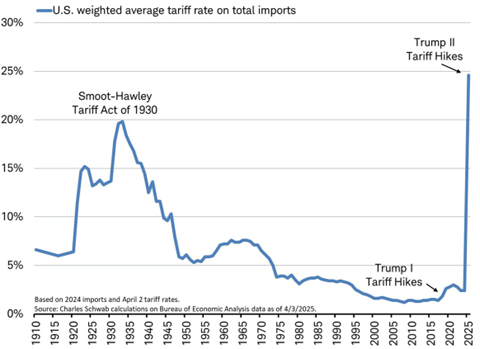President Trump shocked global investors on April 2 (what he declared “Liberation Day”) by announcing a comprehensive set of much higher than expected tariffs. These included a 10% baseline tariff on all imports and unexpected and significantly higher tariffs for certain trade partners, such as 54% for China and 20% for the European Union. These tariffs in aggregate, if implemented and maintained, would result in the effective tariff rate on all imports rising to 24%, putting it at a 125-year high.

In response to Trump’s announcement, global equity markets suffered sharp declines. After closing higher on Wednesday, S&P 500 futures dropped significantly as Trump laid out his plan, and on Thursday, April 3, the S&P 500 fell 4.84%, making it one of the worst single days in market history. European and Asian stock indexes also fell meaningfully. The U.S. dollar weakened against major currencies over fears of a slowdown in light of Trump’s protectionist policies.
Perhaps the most surprising aspect to the announcements was the equation used to arrive at “reciprocal” tariff levels. This so-called “reciprocal tariff” is a bit of a misnomer because they do not truly reciprocate the existing tariff levels imposed on the U.S. by other countries. Instead, these tariffs have been based primarily on current trade deficits, meaning that countries with larger trade surpluses with the U.S. are being subjected to higher tariffs—whether or not they impose high tariffs on U.S. goods. In this way, the announced tariffs seem to be more of a blunt tool aimed at reducing trade deficits.
There are still many lingering questions, including what potential retaliatory measures will come from countries hit with tariffs. Our expectation is that trade partners will retaliate to varying degrees, if not simply for their own political motives. There are also continuing questions about whether these tariff levels will remain in place or possibly be lowered, what their impact will be on the Fed’s monetary policy, and how they will affect global economic growth and trade relations.
It goes without saying that these announced tariffs have injected a big dose of additional uncertainty in the financial markets, and we understand that such developments can be worrying. Please know that our team is working hard and actively analyzing potential impacts, as well as potential opportunities.
We plan to cover the events and impacts of “Liberation Day” in more detail within our upcoming First Quarter Investment Commentary.
In the meantime, we know that the drive to take action during concerning times can be difficult to resist. In our role as wealth advisor to our clients, we take seriously our responsibility to help guide thoughtful decision making and wise action. For that reason, we direct you to our post, “Steady Guidance in Uncertain Times” which covers how we advise clients through times of uncertainty.
Important Disclosure
This written communication is limited to the dissemination of general information pertaining to Litman Gregory Wealth Management, LLC (“LGWM”), including information about LGWM’s investment advisory services, investment philosophy, and general economic market conditions. This communication contains general information that is not suitable for everyone. The information contained herein should not be construed as personalized investment advice and should not be considered as a solicitation to buy or sell any security or engage in a particular investment strategy.
There is no agreement or understanding that LGWM will provide individual advice to any investor or advisory client in receipt of this document. Certain information constitutes “forward-looking statements” and due to various risks and uncertainties actual events or results may differ from those projected. Some information contained in this report may be derived from sources that we believe to be reliable; however, we do not guarantee the accuracy or timeliness of such information.
Past performance is no guarantee of future results, and there is no guarantee that the views and opinions expressed in this newsletter will come to pass. Individual client needs, asset allocations, and investment strategies differ based on a variety of factors.
Investing involves risk, including the potential loss of principal. Any reference to a market index is included for illustrative purposes only, as it is not possible to directly invest in an index. Indices are unmanaged, hypothetical vehicles that serve as market indicators and do not account for the deduction of management feeds or transaction costs generally associated with investable products, which otherwise have the effect of reducing the performance of an actual investment portfolio.
Nothing herein should be construed as legal or tax advice, and you should consult with a qualified attorney or tax professional before taking any action. Information presented herein is subject to change without notice.
A list of all recommendations made by LWM within the immediately preceding one year is available upon request at no charge. For additional information about LGWM, please consult the Firm’s Form ADV disclosure documents, the most recent versions of which are available on the SEC’s Investment Adviser Public Disclosure website (adviserinfo.sec.gov) and may otherwise be made available upon written request to [email protected]
LGWM is an SEC registered investment adviser with its principal place of business in the state of California. LGWM and its representatives are in compliance with the current registration and notice filing requirements imposed upon registered investment advisers by those states in which LGWM maintains clients. LGWM may only transact business in those states in which it is noticed filed, or qualifies for an exemption or exclusion from notice filing requirements. Any subsequent, direct communication by LGWM with a prospective client shall be conducted by a representative that is either registered or qualifies for an exemption or exclusion from registration in the state where the prospective client resides.

